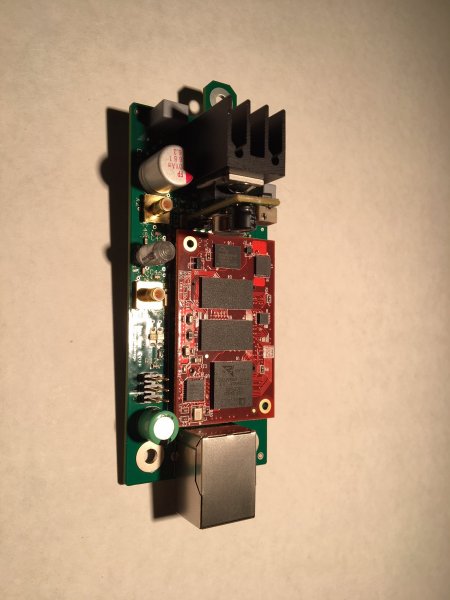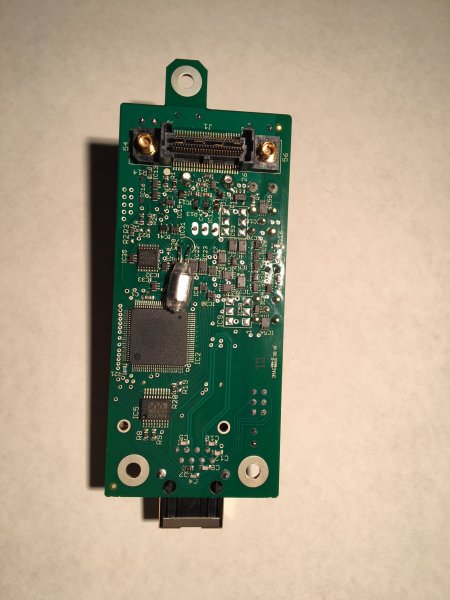Empirical Audio is now offering OEM both XMOS galvanically isolated USB and Ethernet DLNA modules for DAC front-ends.
These can be used in your new or older DAC designs to improve their performance significantly. The jitter of these modules is the lowest in the industry, less than 10psec. We use the latest Crystek oscillator technology with -135dB phase jitter noise floor. -100dB at 10Hz, but its our clever design, GHz connectors and power regulation/distribution that enables the really low jitter numbers at the output. Simpler modules are not even close. You can compete at the highest levels with these modules.
The modules are the same form-factor and have a standard interface on a stacking connector, so they can be swapped out enabling you to offer both Ethernet and USB in the same DAC. No soldering needed. The modules have capability for local oscillators as well as connection using SMB connectors to an external clock source. The modules use precision 4-layer PC boards with silver plating. Many of the traces are impedance controlled. These are designed by an engineer with 38 years digital design experience and was design team lead on the Pentium II at Intel Corp. Professional design work.
The interface has both I2S bus output, including DSD capability and S/PDIF at 3.3V logic levels as well as encoded sample-rate output. MCLK can be output at 256fs or 128fs when tracks are at 176.4 and 192 sample-rates, jumperable. The module also has an I2S bus input, so your other inputs, such as S/PDIF and AES/EBU can be routed through the stacking connector. This allows direct connection of the module I2S bus to the D/A chip or circuits, reducing jitter significantly. No external selector chip needed. Power requirements are 9-12VDC and for the Ethernet also 5VDC, all through the stacking connector. The critical clocks, SCLK and MCLK use coaxial connectors as part of the stacking connector, for best signal integrity.
The Ethernet renderer module supports Open Home DLNA and can be used with Roon when combined with a Sonore device:
https://audiophilestyle.com/forums/topic/29745-sonicorbiter-sonoreupnp-bridge/#comments
Here is the Ethernet module:


If you are seriously interested, we can arrange for 60-day audition of our converters, which use the same modules and output S/PDIF, AES/EBU or I2S bus. If your DAC can connect directly to the D/A avoiding a reclocker, this will give you an idea of the performance.
This is an opportunity to leverage the best sounding USB and Ethernet interfaces on the market.
Steve N.
These can be used in your new or older DAC designs to improve their performance significantly. The jitter of these modules is the lowest in the industry, less than 10psec. We use the latest Crystek oscillator technology with -135dB phase jitter noise floor. -100dB at 10Hz, but its our clever design, GHz connectors and power regulation/distribution that enables the really low jitter numbers at the output. Simpler modules are not even close. You can compete at the highest levels with these modules.
The modules are the same form-factor and have a standard interface on a stacking connector, so they can be swapped out enabling you to offer both Ethernet and USB in the same DAC. No soldering needed. The modules have capability for local oscillators as well as connection using SMB connectors to an external clock source. The modules use precision 4-layer PC boards with silver plating. Many of the traces are impedance controlled. These are designed by an engineer with 38 years digital design experience and was design team lead on the Pentium II at Intel Corp. Professional design work.
The interface has both I2S bus output, including DSD capability and S/PDIF at 3.3V logic levels as well as encoded sample-rate output. MCLK can be output at 256fs or 128fs when tracks are at 176.4 and 192 sample-rates, jumperable. The module also has an I2S bus input, so your other inputs, such as S/PDIF and AES/EBU can be routed through the stacking connector. This allows direct connection of the module I2S bus to the D/A chip or circuits, reducing jitter significantly. No external selector chip needed. Power requirements are 9-12VDC and for the Ethernet also 5VDC, all through the stacking connector. The critical clocks, SCLK and MCLK use coaxial connectors as part of the stacking connector, for best signal integrity.
The Ethernet renderer module supports Open Home DLNA and can be used with Roon when combined with a Sonore device:
https://audiophilestyle.com/forums/topic/29745-sonicorbiter-sonoreupnp-bridge/#comments
Here is the Ethernet module:


If you are seriously interested, we can arrange for 60-day audition of our converters, which use the same modules and output S/PDIF, AES/EBU or I2S bus. If your DAC can connect directly to the D/A avoiding a reclocker, this will give you an idea of the performance.
This is an opportunity to leverage the best sounding USB and Ethernet interfaces on the market.
Steve N.
Last edited:

